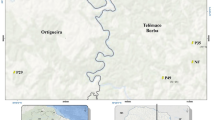Summary
Differences in the productivity of establishedP. radiata plantations on pasture and forest soils were found to be reproducible withP. radiata seedlings in a glasshouse environment. The growth of seedlings on pasture soil exceeded that of seedlings on native forest soil (the ‘primary pasture effect’). After a history of pine on both native and pasture soils a residual effect of pasture on seedling growth was evident (the ‘secondary pasture effect’). However, the effect of a history of pine plantation (the ‘pine effect’) was to decrease the productivity of both native and pasture soil as assessed by seedling growth. These effects were not related to changes due to land management in mycorrhizal infection or in soil structure. The analysis of seedling growth leads to the conclusion that soil fertility, particularly the availability of nitrogen and phosphorus, has changed.
Similar content being viewed by others
References
Alexander, M. 1965 Nitrification.In Soil Nitrogen. Eds. W. V. Bartholomew and F. E. Clarke. Agronomy10. Am. Soc. Agron. Inc. Publisher, Madison, Wisconsin.
Bowen, G. D. and Theodorou, C. 1969 The influence of pH and nitrate on mycorrhizal associations ofPinus radiata. Aust. J. Biol. Sci.17, 59–67.
Donald, C. M. 1970 The pastures of southern Australia.In The Australian Environment. Ed. G. W. Leeper. CSIRO/Melbourne University Press, 4th ed.
Haines, L. W., Maki, T. W. and Sanderford, S. G. 1973 The effect of mechanical site preparation treatments on soil productivity and tree (Pinus taeda L. andP. elliottii Engelm. var.elliottii) growth.In Forest Soils and Forest Land Management. Proceedings of the Fourth North American Forest Soils Conference, Quebec. Eds. B. Bernier and C. H. Winget. Les Presses de l’Université Laval, Quebec.
Harley, J. L. 1972 The Biology of Mycorrhiza. Plant Science Monographs. Prof. Nicholas Polunin, (Ed.) 2nd ed., Leonard Hill Ltd., London.
Jackson, M. L. 1962 Soil Chemical Analysis. Constable & Co. Ltd., London.
Lamb, R. J. and Richards, B. N. 1974 Inoculation of pines with mycorrhizal fungi in natural soils—1. Effects of density and time of application of inoculum and phosphorus amendent on mycorrhizal infection. Soil Biol. Biochem.6, 167–171.
Lamb, R. J. and Richards, B. N. 1974 Inoculation of pines with mycorrhizal fungi in natural soils — II. Effects of density and time of application of inoculum and phosphorus amendent on seedling yield. Soil Biol. Biochem.6, 173–177.
Likens, G. E., Borman, F. H. and Johnson, N. M. 1969 Nitrification: Importance to nutrient losses from a cutover forested ecosystem. Science N. Y.163, 1205–1206.
Mague, T. H. and Mague, F. C. 1974 A simplified procedure for the determination of particulate organic nitrogen.In Research on the Marine Food Chain. Report for June 1973-June 1974. Marine Food Chain Research Group, University of California Institute of Marine Research. pp 415–429.
Marks, G. C. and Foster, R. C. 1967 Succession of mycorrhizal associations on individual roots ofPinus radiata. Aust. For.31, 193–201.
Martin, W. S. 1944 Grass covers in their relation to soil structure. Emp. J. Exp. Agric.12, 21–32.
Richards, B. N. 1965 Mycorrhiza development of Loblolly pine seedlings in relation to soil reaction and the supply of nitrate. Plant and Soil22, 187–199.
Skinner, M. F. and Bowen, G. D. 1974 The penetration of soils by mycelial strands of mycorrhizal fungi. Soil Biol. Biochem.6, 57–61.
Smith, W. H., Borman, F. H. and Likens, G. E. 1968 Response of chemo-autotrophic nitrifiers to forest cutting. Soil Sci.106, 471–473.
Steinbrenner, E. C. and Gessel, S. P. 1955 Effect of tractor logging on soils and regeneration in the Douglas-fir region of south-western Washington. Proc. Soc. Am. For.55, 77–80.
Van der Weert, R. 1974 Influence of mechanical forest clearing on soil conditions and the resulting effects on root growth. Trop. Agric. Trinidad51, 325–331.
Williams, C. H. 1962 Changes in nutrient availability in Australian soils as a result of biological activity. J. Aust. Inst. Agric. Sci.28, 196–205.
Verstraete, W. and Voets, J. P. 1977 Soil microbial and biochemical characteristics in relation to soil management and fertility. Soil Biol. Biochem.9, 253–258.
Author information
Authors and Affiliations
Rights and permissions
About this article
Cite this article
Skinner, M.F., Attiwill, P.M. The productivity of pine plantations in relation to previous land use. Plant Soil 60, 161–176 (1981). https://doi.org/10.1007/BF02374101
Received:
Revised:
Issue Date:
DOI: https://doi.org/10.1007/BF02374101




